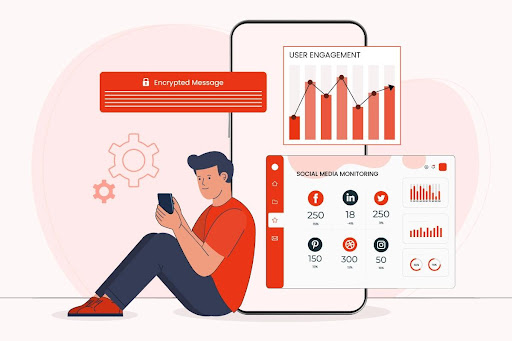- 07 February 2023
- by Andrej Fedek
- Blog, Social Media
- 0 Comments
The use of social media and instant messaging applications has exploded in recent years. This trend has been driven by the widespread adoption of smartphones and the increasing popularity of social media platforms like Facebook, Twitter, and Snapchat.
With more and more people using these applications to communicate, there is a growing need for businesses to be able to monitor these communications.
Today, most social media sites allow users to monitor social media and see what others say about their company. It is especially true for firms with customer-facing employees, such as retail stores, restaurants, and hotels.
According to SocialMediaToday, approximately 71% of businesses believe that monitoring social media offers valuable insights into consumers that can be shared with other teams.
Monitor social network conversations to know what people say about your brand online. Analyzing social media customer reviews, monitoring trends over time, and analyzing usage statistics are all part of this process.
There are a few different methods to monitor social media and instant messaging. The most common method is to use a third-party application that can track and record all communications. Another popular method is to use the built-in features of some of the more popular instant messaging applications, such as WhatsApp and Facebook Messenger.
This article will provide an overview of how to monitor social media and instant messaging. It will also discuss the importance of each method.
What is Social Media Monitoring?
Social listening and social monitoring are often used interchangeably. Social media intelligence refers to both forms, but they mean different things. Monitoring lets you know what your customers think. In contrast, social listening explains why those conversations take place.
It is a method of monitoring conversations around products, brands, and campaigns. The process also involves tracking hashtags, mentions, and keywords related to your brand to stay informed about your industry and audience.
What is Instant Messaging Monitoring?
Instant messaging is a form of real-time communication between two or more people that takes place via text. So, monitoring instant messages is pivotal to ensuring anything from future investments to confidential trade secrets stays under wraps until the right time.
Instant messaging monitoring helps you respond immediately in real-time when data leaks, enabling the implementation of damage control measures and preventing the information from spreading further.
How to set up monitoring for social media and Instant messaging?
In today’s digital age, social media and instant messaging have become integral to our personal and professional lives. However, it’s essential to monitor these platforms to ensure that your brand’s reputation and sensitive information are protected. But how?
Let’s explore the following steps for setting up monitoring for social media and instant messaging.
- Identifying platforms to monitor
The first step in setting up monitoring is to identify which platforms you need to monitor. This will depend upon where your target audience is active, as well as which platforms your organization uses for communications and marketing.
Some popular social media platforms include Facebook, Twitter, Instagram, LinkedIn, and Youtube. On the other hand, instant messaging platforms include Whatsapp, Facebook Messenger, Instagram, Signal, Telegram, etc.
In general, you need to follow the following strategy:
- Evaluate your target audience’s social media habits.
- Determine which platforms are most relevant for your brand or organization.
- Consider which platforms are commonly used for communication and marketing within your organization learn how to monitor Twitter
- Searching for monitoring tools
Once you’ve identified the platforms you need to monitor, you can look for monitoring tools that you will be using. Social media monitoring tools enable you to track multiple social media accounts at once. It’s similar to instant messaging.
Some reliable social media monitoring tools namely Picmaker, Sprout Socials, ZoomSphere, Google Alerts, Hootsuite, Nexalogy, Keyhole, Teramind, etc. These tools provide features such as keyword monitoring, sentiment analysis, real-time alert, and more.
In general, you need to follow the following strategy:
- Research and compare different tools that you will find in the market.
- Choose a tool that fits your organization’s needs and budget tool
- Create an account with the chosen tool, then connect your social media and instant messaging accounts.
- Defining monitoring criteria
Once you’ve set your monitoring tools, the next step is to define your monitoring criteria. This includes setting up keywords to track, defining your target audience, and determining what type of content you want to monitor.
For example, you may want to monitor brand mentions, customer complaints, or competitor activity. You can also set up monitoring for specific dates and times to ensure that you’re capturing the most relevant data.
In general, you need to follow the following strategy:
- Identify your search terms
You should search for keywords or terms related to your business. You should use keywords that people use to describe your company. It encompasses the name and words that people use to describe your brand/business.
Take a look at the words that are most commonly used in your industry. You must keep up with market trends and identify niches to target to succeed in your business. You should create a list of words usually used in your industry.
For example, if you have a restaurant, people will mention your food items more than the restaurant managers. You must find that search term. When you know the best niches to your products, you can stay on top of marketing.
- Set up your keywords in your tool
Your choice of tool will determine this. In our opinion, simultaneous and saved searches indicate how good a tool is.
The hashtags for your business can be anything like #socialmediamarketing, #SEO, etc. If you want location-based hashtags, you can use #UnitedStatePark, #California, etc.
For the keyword, you can use your brand name, brand manager name, product name, and so on.
Make sure that hashtags or keywords are relevant to your brand. Otherwise, it can backfire on your strategy. And while adding search terms more than once, you should use space rather than commas. It provides results, including all terms.
- Check your streams daily
If you post the content daily, you must check them from time to time. It is essential to stay up to date with your streams. It will help you know what works for you and what does not.
You will know what type of posts grab the audience’s attention and how long it takes to reach the wider audience. Remember that each social site has different stream functionality.
- Revisit your keywords time and again
The process of monitoring is never-ending. You must check your social media to see whether your keyword search catches everything you thought or if you need to filter out some.
It is necessary to make adjustments after some time to stay on the trend. In case you find some unrelated results, you can tighten them, whereas if you find fewer results, consider widening them.
It doesn’t take much effort to monitor social media and instant messengers. As a matter of fact, most of the work is automated. All you have to do is create your accounts and search for related content.
What to Monitor on Social Media?
The majority of businesses could benefit from social media monitoring. And for social media monitoring, several tools are available on the internet. Some of the best social media monitoring tools are Sprout Social, Buffer, Hootsuite, Tweetdeck, etc.
You can monitor public posts, private messages, and user engagement on social media.
- Monitor public posts
Moreover, social media monitoring goes beyond direct mentions and comments. Posts that mention your brand without tagging you are also covered. You won’t receive notifications for these posts if you don’t set up your social monitoring tool.
Using social mentions, social media managers can read what users have said about a conversation that is relevant to them or their business. In particular, this can be helpful if someone has made a negative comment. Customer satisfaction can be increased if you respond quickly to their comments.
Additionally, you can view other participants’ comments. You can use this information to understand your customers’ needs and interests better. You can also use it to generate ideas for future posts.
- Monitor private messages
Further, you can monitor private messages and learn about the customers and prospects. It will help you make a strong marketing strategy, customer support, product development, and sales decisions.
In social media monitoring, you don’t just read social conversations. Social media marketers can also post their own messages. You can ask questions to your audience or make announcements of your upcoming products or any news.
- Monitor user engagement
In addition to private messages, you can monitor user engagement on social media. By monitoring user engagement, you can do quantitative and qualitative research. Quantitative research includes analytics and metrics, whereas qualitative research includes inspiration for posts and strategies.
Monitoring user engagement will help you to know the relevant hashtags, keywords, social share of voice, trends, social ROI, and so on.
What to Monitor on Instant Messaging?
Many businesses today use some form of instant messaging (IM) as a way for employees to communicate with each other. Because of the increase in IM use, many businesses are now starting to monitor employee IM conversations. While employee privacy is a concern, there are a few good reasons for businesses to consider setting up IM monitoring.
If you’re wondering what to monitor on IMs, you should focus on group chats and direct messages. It’s because instant messaging monitoring will provide information about a user’s profile, shared files, message content, and timestamps, among other things.
- Monitor group chats
The purpose of corporate instant messaging is not to have personal conversations but rather to conduct business. In light of this, it is your right to know what your employees say when they speak on behalf of your company, whether to colleagues or clients.
Monitoring group chats can boost agent productivity, help social media managers retain customers, and facilitate challenging interactions.
- Monitor direct messages
When you monitor the direct messages, you will get to know how customers and your agent interact with each other. And if there are weaknesses on your agent’s side, you can coach them.
Although it’s easy to blame external parties for bad press and industry rumors, leaks may come from within your organization. Get the tools you need to defend yourself and respond swiftly to threats.
How to evaluate the Data on Social Media?
You can use social media monitoring tools and see what people are saying about your brand from the data you get.
And with the data, you can track how your competitors are performing. By using that information, you can apply the trick depending on whether they are succeeding or losing.
By evaluating the data, you can do the following task.
- Identifying trends and patterns
Utilizing social media tools to monitor social media and instant messaging will help you identify patterns and social media trends. What new memes, ideas, or aesthetics are popping up recently? See if there are any ways to use them to reflect your brand.
- Analyzing sentiment
Brands must know what their audiences think about them. And for that, analyzing social media sentiment will help.
Social media sentiment analysis allows brands to monitor their own and their competitors’ online conversations in real-time. The research also enables them to quantify the degree of positivity and negativity they receive.
By analyzing social media sentiment, you can learn what people are saying about your business online. It will help you to be aware of what people say, and you can engage with them without making off-key mistakes.
- Taking action based on findings
For brands to succeed on social media, social monitoring is essential. For example, new customers don’t deserve high-pressure sales pitches (informative lectures or stand-up routines) when they first walk through the door. First, listen to what they’re saying and figure out what they need.
Further, you can react and do further work based on the findings. By analyzing the data, you can gain an insight into what customers want from you and your companies, as well as their expectations from other companies.
When you find issues or complaints about your brand, you can immediately solve that and improve your reputation. But if you can’t see the problems or fans complain, you will miss the opportunity to solve them.
Conclusion
Social media and instant monitoring software are perfect for business owners who want to improve customer service and boost the performance of their teams.
Social media and instant messaging monitoring can be time-consuming and complex. However, this is important to ensure that your business operates efficiently and effectively.
You can use social media monitoring to direct your social media outreach. Rather than trying to wing it, you can plan your content.
Further, monitoring social media and instant messages using tools such as Sprout Socials and Hootsuite will help you to know the issues and address them directly. It will boost customer satisfaction and reputation management and offer a business opportunity and brand awareness.
That’s why social media and instant messaging monitoring have become extremely important. A monitoring program protects not only your brand’s reputation but also your bottom line.

Andrej Fedek is the creator and the one-person owner of two blogs: InterCool Studio and HarmonyStart. As an experienced marketer, he is driven by turning leads into customers with White Hat SEO techniques. Besides being a boss, he is a real team player with a great sense of equality.




